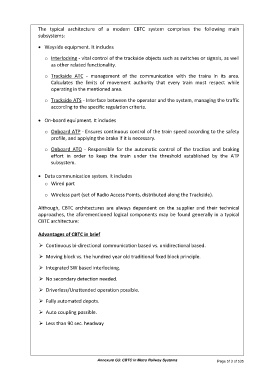Page 570 - IRSEM_Main Book
P. 570
The typical architecture of a modern CBTC system comprises the following main
subsystems:
Wayside equipment. It includes
o Interlocking - vital control of the trackside objects such as switches or signals, as well
as other related functionality.
o Trackside ATC - management of the communication with the trains in its area.
Calculates the limits of movement authority that every train must respect while
operating in the mentioned area.
o Trackside ATS - Interface between the operator and the system, managing the traffic
according to the specific regulation criteria.
On-board equipment. It includes
o Onboard ATP - Ensures continuous control of the train speed according to the safety
profile, and applying the brake if it is necessary.
o Onboard ATO - Responsible for the automatic control of the traction and braking
effort in order to keep the train under the threshold established by the ATP
subsystem.
Data communication system. It includes
o Wired part
o Wireless part (set of Radio Access Points, distributed along the Trackside).
Although, CBTC architectures are always dependent on the supplier and their technical
approaches, the aforementioned logical components may be found generally in a typical
CBTC architecture:
Advantages of CBTC in brief
Continuous bi-directional communication based vs. unidirectional based.
Moving block vs. the hundred year old traditional fixed block principle.
Integrated SW based interlocking.
No secondary detection needed.
Driverless/Unattended operation possible.
Fully automated depots.
Auto coupling possible.
Less than 90 sec. headway
Annexure G3: CBTC in Metro Railway Systems Page 513 of 535

